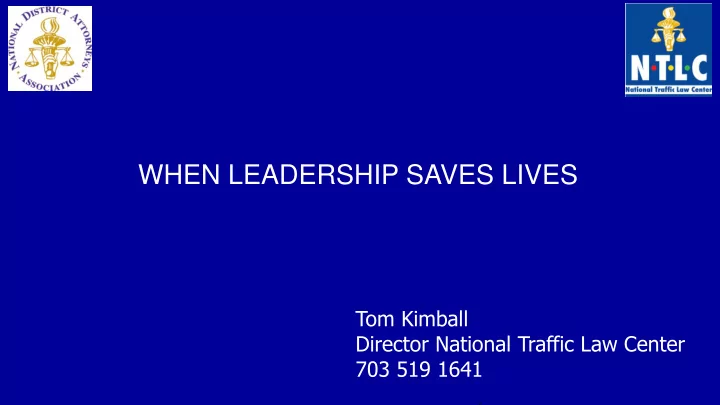

WHEN LEADERSHIP SAVES LIVES Tom Kimball Director National Traffic Law Center 703 519 1641 9
CAVEAT: "This presentation includes the works of others. These works are included under the fair use exemption of 17 U. S. C. 107. The works have been prepared according to the multimedia fair use guidelines and are restricted from further use.”
TRAFFIC SAFETY IS PEOPLE CENTERED Who gets assigned to traffic & Why? How are they trained? How trained for the marijuana issue? How are they supported? How do we know if they are doing good work? Expertise trusted/honored? 9
Jamie Gallagher Robyn Mitchell Erin Shamy Deputy Attorney General Division of Criminal Justice Deputy Attorney General Division of Criminal Justice 25 Market Street Division of Criminal Justice 25 Market Street PO Box 086 25 Market St. P .O. Box 085 Trenton, NJ 08625-0086 P .O. Box 085 Trenton, New Jersey 08625 Phone: 609 3760 2398 Trenton, NJ 08625-0085 Phone: (609) 376-2394 Fax: 609.341.2077 Phone: 732 282 6054 Fax: (609) 341-2077 Email: mitchellr@njdcj.org Email: shamye@njdcj.org Email: Gallagherj@njdcj.org
SO MUCH MARIJUANA….so many myths 1)Marijuana is harmless: Except for: mental illness, heart disease, cancer, lung disease and stroke and emergency room visits, 9
SO MUCH MARIJUANA….so many myths 2) Marijuana is medicine: Rejected for medicinal use by prominent national health organizations Combustible leaf marijuana has no medical contribution In medical marijuana states, less than 3% of users have cancer, AIDS, glaucoma, etc 9
SO MUCH MARIJUANA….so many myths 3) The marijuana “high” only lasts a short time: Acute impairment lasts 24 hours. 9
SO MUCH MARIJUANA….so many myths 4) Presence-in-system testing is unreliable because it does not measure impairment: Dr Fourney 9
SO MUCH MARIJUANA….so many myths 5) Marijuana is not addictive: 1 in 10 adult marijuana users will become dependent to the point of requiring treatment. 1 in 6 adolescent marijuana users develop dependence. 9
SO MUCH MARIJUANA….so many myths 6) Marijuana is not a gateway drug. 2-5 times greater risk of using other drugs when marijuana is the onset drug. Frequency of marijuana use is significant with other illicit drugs of abuse and dependence Majority of individuals seeking drug treatment list marijuana as their gateway drug 9
SO MUCH MARIJUANA….so many myths 9
SO MUCH MARIJUANA….so many myths 9
Dilated Pupils Green Tongue Reddened Conjunctiva
Time from last “smoking event” Marijuana 10-30 minutes • Peak 2-3 hours • Duration 3-6 hours • Dissipates Up to 24 hours • Residual Effects The method of ingestion (e.g. smoked versus consumed in an edible) will affect the peak and duration of effects (and generally result in a “lower” high.
SFSTs are only valid for alcohol, they do not show anything for drugs Study published April 2016 shows that SFSTs, particularly when viewed in totality with DRE eye examinations, were validated for cannabis impairment. 1. Hartman, Rebecca L., Richman, Jack E., Hayes, Charles E., Hueistis, Marilyn A., 2016. “Drug Recognition Expert (DRE) Examination Characteristics of Cannabis Impairment”
Mental v Mental v. . Phy Physical sical Impair Impairment ment MARIJUANA tends to stay in the brain (mental impairment is primary) ALCOHOL AND OTHER DRUGS (generally) include more obvious physical impairment
Attack Officer has no medical expertise or training Response Focus on the DRE’s training Focus on the DRE’s experience – in life & field Discuss toxicological confirmation
Attack Medical Condition caused his behavior Response One major purpose of the personal contact phase and pre-test conversation is to determine if the subject may be suffering from an injury or some other condition not necessarily related to drugs. Problems with legs, eyes, etc
Attack Defendant does not exhibit all the possible signs and symptoms of a drug category Look what I did right/Focus on what is NOT there Response It is uncommon to have every symptom Not everyone has exactly the same reaction Effects may differ by tolerance, dose, type of alcohol and context Poly-drug use may be a factor Describe what is there
Attack Other factors like fatigue caused the signs the DRE observed Response Not a challenge to the observations, but the cause The 12-step process is meant to eliminate other explanations The factors may explain a few but not all of the signs observed
Entitlement is not a legally recognized defense Defendant may justify impairment but not the decision to drive
The range of drug levels within which most patients will experience significant therapeutic effect without an undesirable degree of adverse reactions EVERY drug has a side effect Intended vs. unintended Therapeutic ranges on drug reports are merely a guide, not a “limit” of impairment
Therapeutic Ranges • Therapeutic concentrations of many drugs can cause severe driving impairment
Response Is It a Valid Prescription? Taken per Rx Doctor shopping = Multiple Rx Family Rx Forged Rx Examine the prescription warning labels or look up the medicine in the PDR Investigate the prescribed dosage vs. the amount taken
Remember prosecutors have to convince jurors that Defendant was impaired when operating and not specifically how he became impaired Need to get beyond the identification bias
Ignition Interlock Transdermal monitoring 24/7 monitoring of breath/drugs DRE Program Advanced Roadside Impaired Driving Enforcement
TRUSTING THE TOOLS IN THE TOOLBOX ignition interlock 9
24/7 MONITORING PROGRAMS
https://www.rand.org/health/projects/24-7.html
• PBT (Breath test) - $1.00 per test ($2.00 per day). • SCRAM (Bracelet) - $5.00 per day monitoring fee. • Drug Patch - $50.00 per patch. • U/A (Urinalysis) - $5.00 per test and $25.00 for laboratory confirmation.
Around the Country: One Complaint: The DRE’s are not used enough!
Tom Kimball tkimball@ndaajustice.org 571 457 6624
Recommend
More recommend